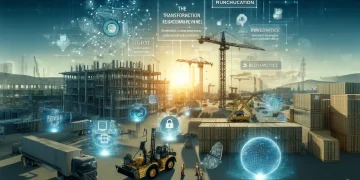How is Technology Transforming the Construction Supply Chain?
The construction industry is on the brink of a significant transformation, driven largely by technological advancements. Unlike other sectors, construction has been slow to adopt digital solutions, relying heavily on traditional methods. However, this presents a substantial opportunity for innovation, particularly in procurement processes.
Recent studies indicate that a significant number of senior procurement managers in the construction sector face challenges in finding suitable suppliers. Additionally, a considerable proportion of contractors still depend on senior decision-makers for purchasing decisions, highlighting inefficiencies within the industry.
Technological advancements provide a pathway to address these inefficiencies, streamlining procurement by simplifying the search for suppliers, enhancing financial management, and improving the coordination of equipment and material delivery. These innovations also promise to shorten and simplify supply chains, making them more sustainable and localized.
Current Challenges in Construction Supply Chain Management
The construction sector, like many others, has been impacted by inflation and rising energy costs. However, a major internal challenge is its historical underinvestment in research and development (R&D). This has left the sector as one of the least digitized industries, particularly in Europe.
Improving procurement processes offers significant potential for construction firms to boost profit margins. Yet, procurement managers report issues such as slow service, last-mile delivery challenges, communication breakdowns between suppliers and contractors, equipment quality concerns, and inefficiencies in purchase order processing. The industry’s adherence to traditional practices has hindered its ability to address these problems with agility.
Investing in technology is essential for enhancing operational efficiency and maintaining competitiveness in the construction sector.
The Role of Emerging Technologies: AI, IoT, and Blockchain
Emerging technologies like Artificial Intelligence (AI), the Internet of Things (IoT), and blockchain are poised to revolutionize construction supply chain management. Simple technological solutions, such as digitizing product catalogs, quotations, and invoicing, can help the construction industry catch up with other sectors.
Modular construction, although not a new concept, is gaining traction due to advancements in design and material technology. This method, which involves constructing building modules off-site and then assembling them on-site, offers significant benefits in terms of speed, cost, and sustainability.
IoT technology is increasingly being used to manage equipment utilization more effectively. For instance, on-board telematics can help rental customers monitor equipment use and promptly off-hire machinery when it is no longer needed, reducing rental costs.
AI is expected to enhance project planning and risk management in construction. By analyzing large data sets, AI can identify the necessary equipment at various stages of a project and reconcile invoices against expected costs, minimizing disputes.
Trends Shaping the Future of Construction Supply Chain Technology
Cash flow issues are likely to influence the adoption of supply chain technologies in construction. Many construction firms, particularly small and medium-sized enterprises (SMEs), have faced financial instability in recent years. Therefore, stable and secure cash flow is critical for their survival.
Digital invoicing and payment systems, which are common in other sectors, are still rare in construction. These systems could provide essential transparency and security for all supply chain stakeholders, helping to resolve disputes and enhance credit risk assessments, thereby supporting a more sustainable future for the construction industry.
Barriers to Technology Adoption in Construction
Despite the benefits, several obstacles hinder the widespread adoption of technology in the construction supply chain. These include industry fragmentation, low investment in technology, and entrenched analog practices. Promoting the cost-saving potential of technology will be crucial for encouraging broader adoption in the future.

















